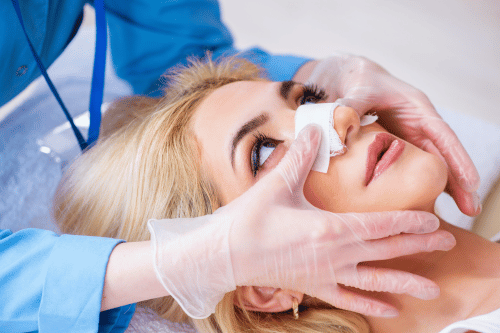How to Recognize Coke Nose Symptoms
Cocaine abuse can have many negative effects on an individual’s health, one of which is a condition known as “coke nose.” This term refers to the damage and symptoms that occur in the nasal passages due to prolonged cocaine use. Recognizing the signs of coke nose can be crucial for early intervention and getting the necessary help.
In this article, we will explore what coke nose is, the symptoms associated with it, and how to help someone who might be suffering from this condition. We’ll also discuss preventative measures and treatment options available for those affected.
What Is Coke Nose?
Coke nose, medically referred to as cocaine-induced rhinitis or septal perforation, occurs when the nasal tissues become damaged due to repeated cocaine use. Cocaine nose is another term used to describe this condition, highlighting the severe nasal damage caused by prolonged cocaine use. Cocaine is often snorted through the nose, which leads to direct contact with the nasal linings. Over time, this can cause significant harm to these delicate tissues.
How Cocaine Affects the Nose
Cocaine is a powerful stimulant that constricts blood vessels. Snorting cocaine leads to direct contact with the nasal linings, causing significant harm to the blood vessels over time. When snorted, it reduces blood flow to the nasal tissues, leading to tissue death, inflammation, and even perforation of the nasal septum (the cartilage dividing the nostrils).
The lack of blood flow can cause the tissues to become necrotic, leading to sores, infections, and a host of other nasal problems. This damage can be severe and often requires medical intervention.

Symptoms of Coke Nose
Recognizing the symptoms of coke nose early can help prevent further damage and facilitate timely treatment. These nasal symptoms can range from mild irritation to severe structural damage. Here are some common signs to watch out for:
Persistent Nasal Congestion
One of the earliest signs of coke nose is chronic nasal congestion. Rebound nasal congestion can occur as a result of prolonged cocaine use, leading to chronic nasal issues. This occurs because the nasal passages are inflamed and irritated, making it difficult to breathe through the nose leading to a persistent runny nose. This symptom might persist even when not using cocaine.
Nosebleeds
Frequent nosebleeds are another common symptom. The damage to the nasal tissue makes it more fragile and prone to bleeding. The damage to the nasal lining makes it more fragile and prone to bleeding. Nosebleeds can occur spontaneously or with minimal trauma, such as blowing the nose.
Nasal Pain and Discomfort
Individuals may experience pain or discomfort in the nasal area. This can be due to inflammation, sores, or the beginning stages of tissue necrosis. The pain might be constant or triggered by touching the nose.
Loss of Smell
As the nasal tissues become more damaged, the sense of smell can be affected. Some individuals with coke nose report a diminished or complete loss of their ability to smell.

Advanced Symptoms
Nasal Septum Perforation
In severe cases, the nasal septum can become perforated. This means that there is a hole in the nasal cavity cartilage that separates the nostrils. Septal perforation can lead to difficulty breathing, whistling sounds when inhaling, and further nasal collapse.
External Deformities
Over time, the structural damage can lead to visible deformities of the nose, such as a collapsed nasal bridge (commonly referred to as a “saddle nose”). A saddle nose deformity occurs when the bridge of the nose collapses, creating a saddle-like shape. This is a result of the loss of cartilage and support within the nose.
Frequent Infections
The damaged nasal tissues are more susceptible to infections. Individuals with coke nose may experience frequent sinus infections or other nasal infections that are difficult to treat.
How to Help Someone with Coke Nose
Recognizing the signs of coke nose is only the first step. If you or someone you know is suffering from this condition, it is important to take action. Here are some steps to consider:
Encourage Seeking Professional Help
The first and most crucial step is to encourage the individual to seek professional medical and psychological help. A healthcare provider can assess the extent of the damage and recommend appropriate treatment options.
Supportive Care
Providing supportive care can help manage symptoms and prevent further damage. In severe cases, reconstructive surgery may be necessary to repair the nasal damage. This might include using saline nasal sprays to keep the nasal passages moist, avoiding further cocaine use, and seeking treatment for any infections.
Rehabilitation Programs for Cocaine Addiction
For those struggling with cocaine addiction, enrolling in a rehabilitation program can be life-changing. These programs offer medical, psychological, and social support to help individuals overcome their addiction and recover their health.
Prevention and Treatment
Preventing Coke Nose
The best way to prevent coke nose is to avoid using cocaine. However, if someone is already using, reducing the frequency and seeking help for addiction can mitigate the risks.
Medical Treatment and Reconstructive Surgery
Medical treatment for coke nose may involve:
-
Topical Treatments: To reduce inflammation and promote healing.
-
Antibiotics: To treat any infections.
-
Surgery: In severe cases, surgery might be needed to repair a perforated septum or other structural issues.

Psychological Support
Cocaine addiction often comes with psychological challenges. Seeking counseling or therapy can help address the underlying issues contributing to cocaine use and support long-term recovery.
Conclusion
Recognizing the symptoms of coke nose is essential for early intervention and treatment. As cocaine abuse progresses this condition can lead to severe nasal damage and other health complications if left untreated. By being aware of the signs and taking appropriate actions, individuals can prevent further damage and seek the help they need to recover.
If you or someone you know is struggling with cocaine use and showing signs of coke nose, it’s important to reach out to healthcare professionals for support and treatment. Early intervention can make a significant difference in recovery and overall health before needing nasal surgery.
Seeking Treatment? We Can Help!
We work with PPO Out of Network Health Insurance Policies
If you or a loved one are struggling with mental health challenges or substance abuse, reach out to Mountain Sky Recovery today. Our team of compassionate professionals is here to support your journey towards lasting well-being. Give us a call at 951-877-5868.
FAQs For Recognizing Coke Nose Symptoms
1. What are the early signs of a "coke nose?"
Early signs of a “coke nose,” medically known as cocaine-induced rhinitis, may include:
- Frequent nosebleeds
- Persistent runny nose or nasal congestion
- Loss of sense of smell
- Difficulty breathing through the nose
- Frequent sneezing
- Soreness or crusting inside the nose
2. How quickly do coke nose symptoms appear after cocaine use?
Symptoms of a coke nose can appear relatively quickly, sometimes within minutes or hours of using cocaine. The severity and duration of symptoms can depend on factors such as the amount of cocaine used, frequency of use, and individual susceptibility.
3. Can a coke nose lead to more serious health problems?
Yes, if left untreated, a coke nose can lead to more severe health problems, such as:
- Perforation of the nasal septum (a hole in the wall that divides the nostrils)
- Chronic sinusitis (inflammation of the sinuses)
- Damage to the cartilage and bone structures of the nose
- Loss of facial structure (in severe cases)
- Increased risk of respiratory infections
4. How is a coke nose diagnosed and treated?
A coke nose is typically diagnosed based on a combination of:
- Physical examination of the nose and nasal passages
- Medical history, including questions about cocaine use
- In some cases, imaging tests like CT scans or X-rays may be used to assess the extent of damage
Treatment for a coke nose often involves:
- Ceasing cocaine use
- Medications to manage symptoms (e.g., decongestants, nasal sprays)
- In some cases, surgery may be necessary to repair damage to the nasal septum or other structures




